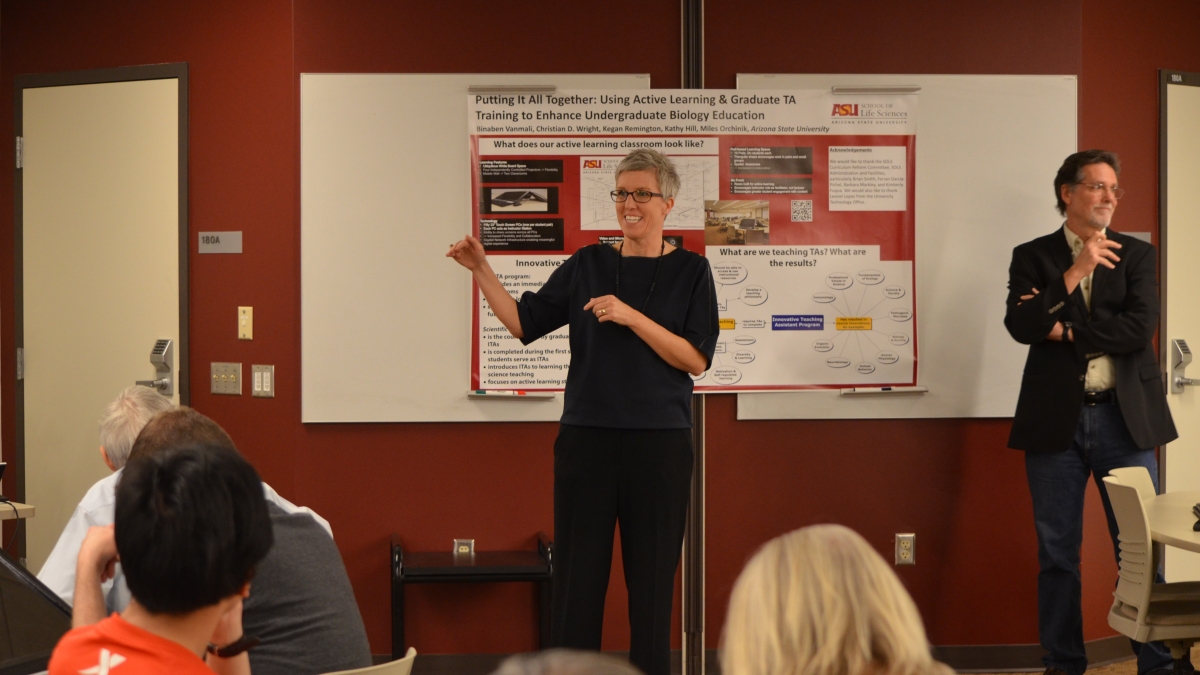'Active learning' workshop aims to strengthen faculty teaching skills

A quarter of the students who entered Arizona State University’s School of Life Sciences last year were, for one reason or another, not prepared for college, according to Miles Orchinik, the school’s associate director of undergraduate programs. To help solve that problem, experts on active learning methods from the fields of science, technology, engineering and math (STEM) facilitated a recent workshop for ASU faculty members.
“We are dealing with one challenge we have at ASU in a very constructive way,” Orchinik said. “President Michael Crow has said we won’t be defined by who we exclude, but who we include and how they succeed. So we’re providing the best educational and developmental experience that we can for all of our students.”
The March 13 event brought national leaders in science education together to discuss new teaching methods with 130 faculty members from across the university.
Breakout sessions focused on topics such as making group projects productive, student assessment beyond grading and engaging students through different modes of active learning. ASU faculty members, including Michelene Chi, director and professor of the Learning Sciences Institute, and Sara Brownell, School of Life Sciences assistant professor, led the sessions alongside out-of-state educators.
To Orchinik, the workshop was one important step toward bettering higher education student outcomes.
“This takes place within the context of a national consensus that we’ve blown it with STEM education,” Orchinik said. “We’re not doing a good enough job across the country in regards to training a diverse population of future scientists.”
In recognizing the problem, many of ASU’s academic units have started working on new ways to improve education and student understanding. For example, School of Life Sciences now provides training in scientific teaching for all of its graduate students.
“The scientific teaching course has become so popular, many students are going on to take the advanced scientific teaching course,” Orchinik said. “We’re also developing a graduate certificate program to teach at the university level.”
In addition, the school started a program called “Innovative TAs,” in which faculty members write proposals to bring graduate student teaching assistants into classes that previously did not have them. This gives undergraduates more individual help inside and outside of the classroom.
Professors are also encouraged to engage students by using active learning methods such as breakout groups and clickers, as opposed to lectures. Students use clickers (small electronic gadgets) to answer multiple choice questions mid-lecture. However, new teaching methods often mean new challenges.
“We recognize that in this ‘active learning’ approach, we don’t teach students, students learn,” Orchinik said. “We help them to learn. It sounds like a subtle difference, but it’s very real. The students have to do more work. That’s the way it is. If you’re going to learn, you’ll have to work to get there.”
The university’s efforts to increase the use of active learning methods in the classroom will be handled by a new partnership. Called the Arizona Science Education Collaborative (ASEC), ASU’s Mary Lou Fulton Teacher’s College and academic units focused on STEM will work together to find solutions. According to Penelope Moon, director of ASEC, the active learning workshop did brings teachers and students together, another important tenant of active learning
“ASU is big, and it can often be a challenge to keep on top of what’s happening down the hall, not to mention across campus,” Moon said. “We hope that our workshop will foster a community of people interested in working together to improve teaching practice.”